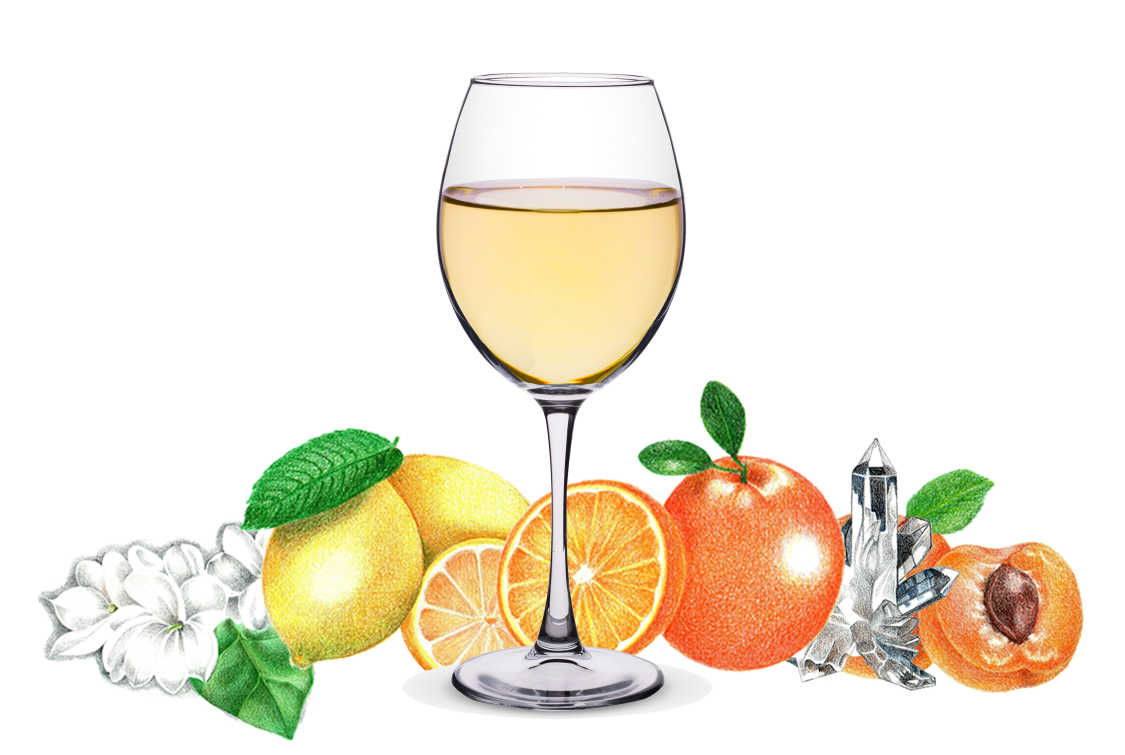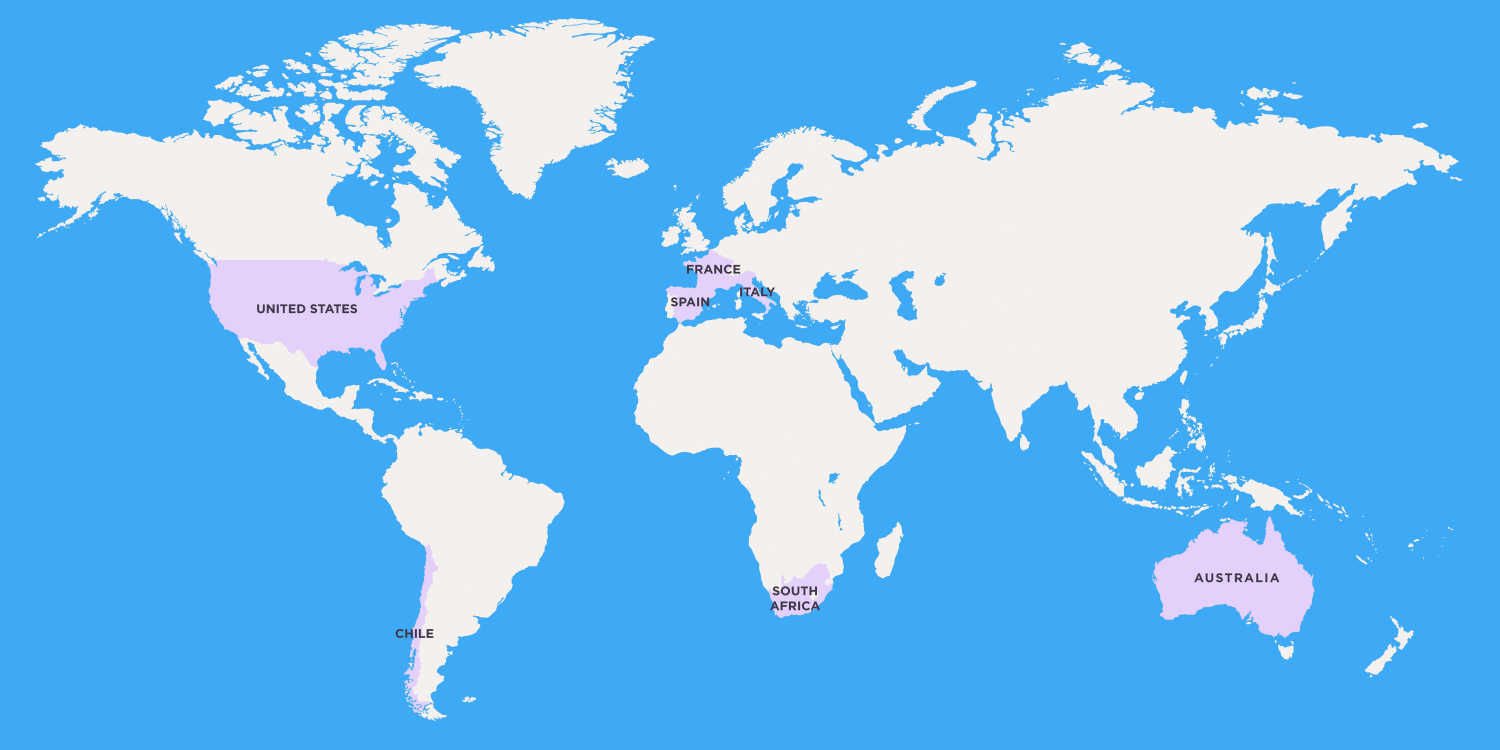What is Moscato Wine?
Muscat wines, including Moscato Wines, are known for a pronounced floral aroma in the bouquet, ripe fruit, and the ability to be made in a variety of styles.
Muscat, also known as Moscato is one of the most searched wine terms on the entirety of the internet and is just one type of wine made from the Muscat family of grape varietals. With grapes that range from white to pink to red, the resulting wines from these grapes are invariably just as unique. Every wine lover should explore the depth and variety of Muscat and Moscato wines.
Of the hundreds of varietals called Muscat, there are four main Muscat grapes used in contemporary winemaking: Muscat blanc à Petits Grains (used to make famously refined and exuberantly floral wines, including Italian sparkling Moscato, white Moscato, moscato blanco, and other iterations), Muscat of Alexandria (most often used to make fortified wines in France and Pisco, a type of brandy, in Chile), Muscat of Hamburg (also known as “Black Muscat” is grown in California to produce sweet dessert wines), and Muscat Ottonel (the most common Muscat in Alsace and Austria as well as across the vineyards of former Yugoslav and Soviet republics). The color variation in the grapes produces similar variation in the finished wines, and different types of Muscat are used to make white wine, red wine, and rosé wine (which are sometimes referred to as "blush" or Pink Moscato).
Moscato wines are known for a pronounced floral aroma in the bouquet, ripe fruity flavors, and the ability to be made in a variety of styles. Muscat is also famous for being one of the few wines to exhibit “grapey” flavors. This grape flavor is one of the reasons the Muscat grape is also grown to be consumed as table grapes or made into raisins.
The most famous iteration of Muscat is Moscato, a sparkling Italian wine made in Piedmont. Asti Spumante and Moscato d’Asti are the classic Italian semi-sparkling and sparkling wines that are made in a DOCG region and referred to as frizzante in Italian. Traditional Moscato wine has low alcohol, low tannins, light fermentation, and is crisp, fruity and fizzy. Pink Moscato utilizes the vibrant aromas and flavors of the Muscat grapes, but is finished with a dash of red wine. The result is a light and sometimes effervescent pink wine with a floral and citrus core and strawberry or cherry notes. Red Moscato is most popular in the United States and generally denotes a style, but is always sweet and full of ripe fruit flavors.

Take The Quiz
Learning about different wine varietals and regions is fun. Take the quiz now to explore wines matched to your unique palate.
Take The QuizIN THIS ARTICLE:
Want personalized wines?
Get your first box of wines for $44.95 + free shipping.

Muscat Wine and Moscato Wine History
Muscat (pronounced musk-at; or Moscato (Italian) moe-skah-toe) is potentially the oldest domesticated grape still used in winemaking. Some ampelographers (scientists that study grapes and grapevines) believe that all winemaking grapes descended from Muscat. While many theories about grape origins are impossible to prove, some have attempted to trace the grape back to the winemakers in ancient Egypt and Persia. Today, most modern scholars believe that the grape was propagated by the Greeks and Romans and spread throughout their empires.
The first verifiable mention of modern Muscat comes from a Franciscan friar in the early 1200s. A few centuries later in the 1600s, it was documented in Alsace, and since then the grape has diversified and been crossed with many other varietals to give us the smattering of grapes bearing the Muscat name.
Fun Fact
While it might sound similar, Muscadine wine is native to the United States and is not related to Muscat!
Moscato Wine Types: Four Major Types of Muscat
Muscat blanc à Petits Grains, also called the muscat blanc grape, is the oldest varietal of Muscat and is likely the same grape spread across Europe by the Greeks and Romans.
Muscat of Alexandria is similarly old but has been found to be a mix of Muscat blanc à Petits Grains and a wild Greek grape. It was spread from the islands of the Mediterranean to the rest of Europe by the Romans.
Muscat of Hamburg also known as “Black Muscat” was created in the greenhouses of Victorian England in the 1850s by crossing Muscat of Alexandria with Black Hamburg grapes.
Muscat Ottonel was also created in the 1850s by winemakers in the Loire Valley mixing Muscat d’Eisenstadt with Chasselas (a Swiss grape).
Today Muscat is grown all over the world, but is particularly popular in Italy for Italian Moscato as well as in the United States for White and Pink Moscato wines .
What does Moscato taste like? Is Moscato Wine Sweet?
Moscato wines and Muscat wines are made in almost every possible style, but are known for their beautiful musky aroma, sweetness, and grapey flavors. Many have a strong citrus core with orange zest, white flowers (particularly orange blossoms), and occasionally peach popping out the glass. Most Muscat has a touch of sweetness.
Other sweet, fruity flavors that are typical of the Muscat grape flavor profile are apricot, tangerine, juicy peach, tropical fruit, and other stone fruits.
Fun Fact
Due to the rich flavors of sweet Moscato, it is often enjoyed as an aperitif or as a mixer for sangria.
-Wine Concierge Tip
Moscato Wine Characteristics
The most notable Muscat characteristic is the heady aroma. Only a few grapes (like Gewürztraminer) can come close to matching Muscat’s beautiful aromas.
The brightness of the aromas help to balance the low acidity in the grapes. Practically this means that Moscato wines as often best drank as young as possible.
Moscato Wine Alcohol Content
The nutritional values in Muscat wines varies greatly depending on two main factors: alcohol and sugar.
The alcohol in Muscat can depend on how ripe the grapes were when harvested, if the winemaker added extra sugar, and how long it was allowed to ferment. Muscat wines are generally low in alcohol, but it is sometimes used in fortified wines which have a much higher a.b.v. than traditional wines.
Fun Fact
Fortified wines have higher a.b.v. (alcohol by volume) than regular wines, usually by adding a neutral spirit.
Some Muscat is sweet, and some Muscat is dry. Sweetness in wine is very specifically defined, but in general the more sugar present in a wine, the more carbohydrates.
How to Serve and Store Moscato Wine
Serving Muscat can be done simply: enjoy at cellar temperature. If you want to experience the wine through multiple stages we recommend chilling the wine and allowing it to warm as you drink, the scents will open as it warms so that you will get the full aromas bursting from the glass. That being said, this is all personal preference. Enjoy your wine how you like it.
Once your wine is cooled it is time to open the bottle. Most likely you will need a standard corkscrew. Muscat does not typically need to be decanted and can be served in standard wine glasses.
How do you store wine? Muscat should be stored in a cool place that does not receive direct sunlight, and preferably in a wine refrigerator or cellar. 55 degrees Fahrenheit is the median temperature for optimal wine storage, but what matters most is consistency. Do not store your Muscat in a place that receives direct sunlight, heat, or too much humidity.
Most Muscat and Moscato wines are not meant to be aged, so enjoy them while they are young. The exceptions to this rule is fortified Muscats coming from Australia or South Africa.
Moscato Wine Food Pairings
Pairing wine has some general rules, but we think the most important rule is to drink Muscat with the food you like. It's a wine that stands up just fine on its own, but if you are looking for specific suggestions for wine and food pairings with Moscato wine, we would suggest trying it with spicy Asian cuisine foods like fragrant Thai dishes or Sichuan cuisine. Sweet Muscat can be a light dessert wine that pairs well with fresh fruit, sweet desserts, and sparkling Moscatos do very well on their own or in a wine and cheese pairing.
Muscat wine regions around the world
Muscat is grown all over the world, but it is not an international grape like Chardonnay, Cabernet, or Merlot. The difficulty of making good Muscat presents many challenges in the vineyard and in the winery. Many of the Muscat grapes grown across the world are not intended for wine, but instead for eating. Here is a brief overview of the regions Muscat is grown for wine.
Fun Fact
Brazil loves Muscat too, and it is used for making delicious sparkling wines that fuel the parties of Carnival.
France:
Many of the best examples of Muscat growing in France are “vins doux naturels” (VDNs) or naturally sweet wines that are fortified with a neutral grape spirit. These come in different styles, but the best examples can be found in the south of France.
There are also great examples of Muscat Ottonel growing in Alsace that are made in both sweet and dry wine variations.
Italy:
Home to Moscato wine, the most famous iteration of Muscat the world over. Muscat blanc à Petits Grains is the primary form of the grape in the country. The best examples come from the the north Italian wine regions in Piedmont which is home to the DOCG Asti Spumante and Moscato d’Asti wines. These wines are light, crispy, effervescent, and full of strong aromas.
Spain:
Muscat, or Moscatel in Spanish is grown largely as table grapes, but it is sometimes used to make fortified wine.
Australia:
Some of the best use of Muscat is in fortified wine from Northern Victoria. This is one of the few examples of Muscat that can and should be aged. With time, these wines darken and develop beautiful tertiary flavors.
South Africa:
The second most famous use of Muscat in the southern hemisphere comes from South Africa in the form of Constantina. This sweet dessert wine was the original wine export to Europe in the 18th and 19th centuries and was all but wiped out by Phylloxera. The past few decades have seen a resurgence of the wine style.
United States:
The most known iteration of Muscat in the United States is Moscato, and in particular White and Pink Moscato, which is many people's introduction to wine in general which should be celebrated.
While Muscat is not the most common wine grape planted around the country there are great examples to be found in Napa (particularly in Stag’s Leap) and in the Finger Lakes region of New York.
Chile:
Used for the tightly regulated Chilean Brandy, Pisco. Muscat-based Pisco’s are highly aromatic and showcase high-quality products.

Take Our Quiz Today
Get award-winning delicious wines from all over the world shipped straight to your door. Take the quiz to get the perfect pairings for your holiday season.
Take The Quiz TodayIN THIS ARTICLE
Want personalized wines?
Get your first box of wines for $44.95 + free shipping.


WinePrint™ by Firstleaf
Are you looking to learn more about your wine preferences? Check out our Wine Print for an in-depth look at your personal tasting profile. Discover your favorite wines, varietals, regions, and tasting notes and get personalized recommendations wherever you are.
Learn More
